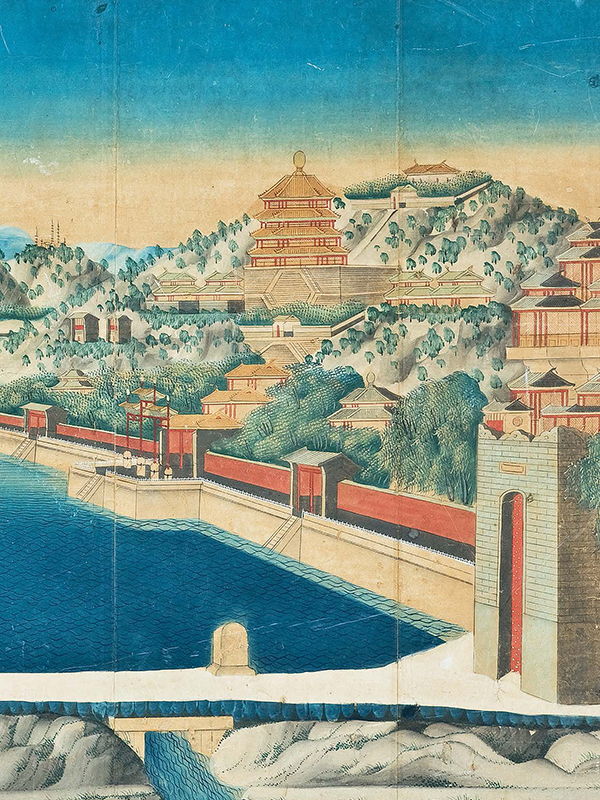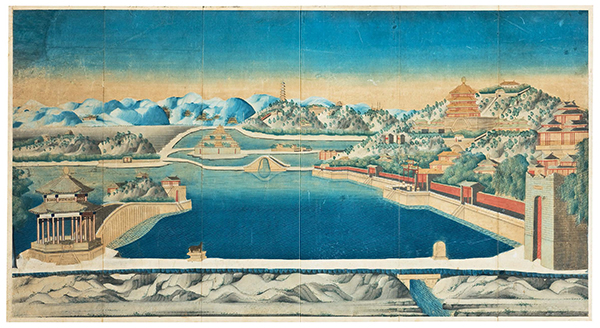Painting of the Summer Palace
A painting in gouache on paper, composed of six vertical panels of equal width, depicting a bird’s eye view of the Yihe Yuan or Summer Palace. The perspective is taken due west and shows Kunming Lake with the Island of the Dragon King and the Seventeen Arch Bridge on the left, and Longevity Hill with the Palace complex dominated by the octagonal Fo Xiang Ge (Tower of Buddhist Incense), on the right. In the foreground is a bronze sculpture of an ox, in the middle background is Yu Quan (Jade Spring) Hill with the seven-tiered pagoda and further buildings, and the Western Hills can be seen beyond.
This charming landscape painting depicts the Summer Palace or Yihe Yuan (literally meaning ‘Gardens of Nurtured Harmony’), located on the outskirts of Beijing. It covers an expanse of 2.9 square kilometers, three quarters of which is water, most of which constitutes the entirely manmade Kunming Lake. In 1749, the Qianlong emperor commissioned work on the imperial gardens on the hill and in 1752 he gave Longevity Hill its present-day name in celebration of his mother’s 60th birthday. The Summer Palace started out life in 1750 as the Qingyi Yuan (Garden of Clear Ripples), when workers reproduced the garden architecture styles of various palaces in China. Kunming Lake was created by extending an existing body of water to imitate the West Lake in Hangzhou. The palace complex suffered two major foreign attacks, the first during the Anglo-French allied invasion of 1860 and the second during the Boxer Rebellion in an attack by the eight allied powers in 1900. The garden survived and was rebuilt in 1886 and in 1902. In 1888 the Summer Palace was given its current name, Yihe Yuan. During most of the 19th century it served as a summer resort for Empress Dowager Cixi (1835 – 1908). One of the most characteristic buildings of the Summer Palace today is the famous Shi Fang or Marble Boat pavilion, constructed first during the reign of Qianlong in 1755. It was destroyed by Anglo-French forces in 1860 during the second Opium War and rebuilt in 1893 at the orders of Empress Dowager Cixi. As this most recognisable of features is not present in this view and unlikely to have been left out by any painter, it can be concluded that this painting must have been produced somewhere between 1860 and 1893. The painting was once dissected evenly into six parts, probably used as a screen, and was then mounted to a complete picture as it is seen now.
Provenance: private collection, France
頤和園彩畫
清 十九世紀下半期 高:96.5 公分 長:178 公分
本橫幅彩畫描繪皇家頤和園景致。位於今北京市西郊,頤和園前身為清漪園,為乾隆十五年(1750)
間,為籌備崇慶皇太后(孝聖憲皇后)的六十大壽而建,並於乾隆二十九年(1764)建成。清漪園的總
體規劃以杭州西湖為藍本,乾隆帝以漢武帝挖昆明池操練水軍的典故將西湖更名為昆明湖,將挖湖土方
堆築於湖以北的甕山,並將甕山改名為萬壽山。同時廣泛仿建江南園林及山水名勝,如鳳凰墩仿太湖、
景明樓仿岳陽樓等等。園內的主體建築為大報恩延壽寺,並有一條長達七百多米尺的長廊,其建築與裝
飾繪畫都相當具有藝術價值。畫作右側可見一八角形三層樓閣,名為佛香閣,是頤和院內體量最大的建
築物,仿武昌黃鶴樓所建。佛香閣背倚萬壽山,遙望左方玉泉山上之玉峰塔,湖心可見十七孔橋,是連
接昆明湖東岸與南湖島的一座長橋。
咸豐十年(1860),清漪園在第二次鴉片戰爭中被英法聯軍大火燒燬。光緒十年至二十一年間(1884
– 1895),慈禧太后還政後退居休養,光緒帝為了展示孝心,並希望慈禧不再干涉政務,下令動用海軍
衙門的經費工程挪款重建清漪園。由於經費有限,乃集中財力修復前山建築群,並在昆明湖四周加築圍
牆,改名頤和園,成為離宮。光緒二十六年(1900)園內建築及文物遭八國聯軍破壞,兩年後修復。本
畫被平均裁切分成六等份,或許曾被改為屏風使用。


